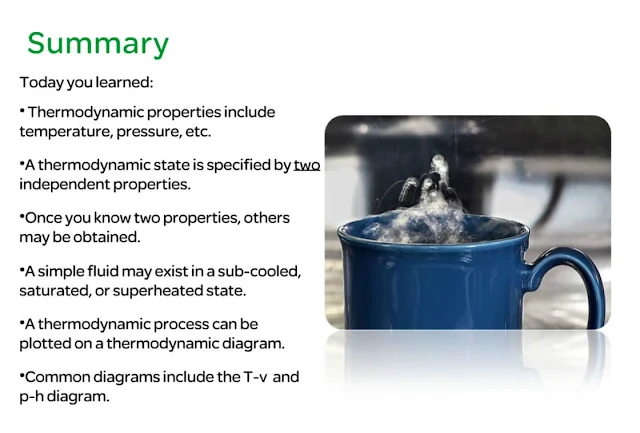A thermodynamic state is specified by _____ thermodynamic properties.
- two independent intensive
- three physical
- a set of related
- pressure and temperature-related
A liquid and vapor in contact with each other where all the other properties remain constant with time is said to be
- frozen
- in equilibrium
- static
- in entropy
A vapor that is heated beyond boiling point is referred to as
- superheated vapor
- latent heated vapor
- overheated vapor
- sensible vapor
A simple fluid may exist in one of three thermodynamic states
- Cooled, inert, heated
- Solid, liquid or vapor
- Refrigerated, liquid or overheated
- Subcooled, saturated or superheated
Intensive properties include volume, mass and energy
- True
- False
What happens when we supply sensible heat?
- The temperature rises
- The pressure rises
- The substance changes state
- All of the above
What happens when we supply latent heat?
- The temperature rises
- The pressure rises
- The substance changes state
- All of the above
On a T-v chart, if a state is plotted on the saturated liquid line, what does it mean?
- The liquid is saturated with heat and starting to transition to a vapor
- The liquid is saturated with heat and completing transition to a vapor
- The liquid is saturated with heat and starting to melt from a solid
- The liquid is saturated with enthalpy and starting to transition to a vapor
Pressure and temperature have a unique relationship. When a liquid is compressed to a higher pressure, it has a different boiling point.
- True
- False
Saturation temperature is effectively the:
- Boilinging point
- Degree of superheat
- point
- FreeDegree of overheat
HVAC (Heating, ventilation, and air conditioning) Thermodynamic States Course Outline
All refrigeration systems involve the movement or transport of heat from a cold region to a warm region. The subject of thermodynamics describes how these heat transports may occur. Thermodynamics is a branch of physical science that deals with the relations between heat and other forms of energy (such as mechanical, electrical, or chemical energy), and, by extension, of the relationships and interconvertibility of all forms of energy. “Thermo” means heat, and “dynamic” refers to energy and change. In cooling applications, we are interested in managing heat, energy, and change, and so a knowledge of basic thermodynamics helps us to grasp the processes that are taking place, for example, in an air-conditioner.
Learning objectives
At the completion of this course you will be able to:
- Define common thermodynamic properties
- Describe the three thermal states
- Plots states and processes on a thermodynamic chart
Course content or material
- 1) Objectives
- 2) Introduction
- 3) Thermal States
- 4) Thermodynamic Properties
- 5) Heat and Energy
- 6) Extensive and Intensive Properties
- 7) Equilibrium
- 8) T-v Diagram
- 9) T-v Case Study
- 10) Sub-Cooled State
- 11) Apply Sensible Heat
- 12) Pressure Relief
- 13) Initial Vaporization
- 14) Saturated State
- 15) Latent Heat
- 16) Final Evaporation
- 17) Superheated Vapor
- 18) Recap
- 19) Pressure-Enthalpy Diagram
- 20) Summary
دورة الديناميكا الحرارية علي جامعة شنايدر للطاقة
وصف الدورة التدريبية:
تتضمن جميع أنظمة التبريد حركة أو نقل الحرارة من منطقة باردة إلى منطقة دافئة. الموضوع يصف الديناميكا الحرارية كيف يمكن أن تحدث عمليات نقل الحرارة هذه. الديناميكا الحرارية هي فرع من العلوم الفيزيائية يتعامل مع العلاقات بين الحرارة وأشكال الطاقة الأخرى (مثل الطاقة الميكانيكية أو الكهربائية أو الكيميائية) ، وبالتالي ، العلاقات بين جميع أشكال الطاقة وقابليتها للتبادل. "Thermo" تعني الحرارة و يشير مصطلح "dynamic" إلى الطاقة والتغيير.
في تطبيقات التبريد ، نحن مهتمون بإدارة الحرارة والطاقة والتغيير ، وبالتالي فإن المعرفة بالديناميكا الحرارية الأساسية تساعدنا على فهم العمليات الجارية ، على سبيل المثال ، في مكيف الهواء.
أهداف دورة الديناميكا الحرارية علي جامعة شنايدر للطاقة
عند الانتهاء من هذه الدورة ، ستتمكن من:
- تحديد الخصائص الديناميكية الحرارية الشائعة
- وصف الحالات الحرارية الثلاث
- يرسم الحالات والعمليات على مخطط ديناميكي حراري
محتوى الدورة أو المواد
- 1) الأهداف
- 2) مقدمة
- 3) الدول الحرارية
- 4) خصائص الديناميكا الحرارية
- 5) الحرارة والطاقة
- 6) خصائص واسعة النطاق ومكثفة
- 7) التوازن
- 8) مخطط T-v
- 9) دراسة حالة T-v
- 10) الدولة المبردة من الباطن
- 11) تطبيق الحرارة المعقولة
- 12) تخفيف الضغط
- 13) التبخير الأولي
- 14) الدولة المشبعة
- 15) الحرارة الكامنة
- 16) التبخر النهائي
- 17) بخار محموم
- 18) خلاصة
- 19) مخطط الضغط - المحتوى الحراري
- 20) ملخص
ما هو علم الديناميكا الحرارية
هو احد العلوم الفيزيائية التي تدرس الحرارة وشكل الحرارة والطاقة الكيميائية والكهربائية والميكانيكية وكيفية انتقال كل منها من حالة الي اخري وكلمة "thermo "تعني الحرارة اما كلمة "dynamic" تعني معدل او تغيير او طاقةما هي الحرارة النوعية specific heat
id كميّة الحرارة اللازمة لرفع درجة حرارة 1 كيلوجرام من المادة درجةً واحدة مئويةًما هي الحرارة المحسوسة Sensible heat
هي كمية الحرارة الازمة لرفع درجة حرارة المادة دون ان تتحول من حالة الي اخري اي ان درجة حرارة المادة لم تصل بعد لنقطة الغليانما هي الحرارة الكامنة Latent heat
هي كمية الحرارة الازمة لتحويل المادة من حالة الي اخري اي المادة تعدت نقطة الغليان وبدأت تتحول الي غازما هو المحتوي الحراري Enthalpy
هو مجموع كل من الحرارة المحسوسة والكامنة الازمة لتحول اي سائل الي غاز
Read Also
- MCQ on Building Controls I: An Introduction to Building Controls | Primo Engineering
- MCQ on Building Controls II: Control Sensors | Primo Engineering
- MCQ on Building Controls III: Introduction to Control Loops | Primo Engineering
- MCQ on Measurement and Verification Including IPMVP Course
- MCQ on A Comparison of AC and DC Power Distribution in the Data Center Answer
- MCQ on HVAC Thermodynamic States | ENERGY UNIVERSITY COURSES
- تفاصيل مسابقة جامعة شنايدر للطاقة 2020 "Energy university championship "لطلاب هندسة كهربائية

